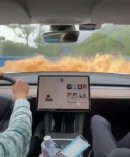The effects of Hurricane Ida and tropical storm Fred mean that the used car market will have more flood-damaged vehicles in the upcoming months. Some of these damaged vehicles might even be new vehicles in dealer lots, but the used ones have a bigger shot at flying under the radar. The worst part about the entire situation is that these damaged vehicles might get sold to unsuspecting customers as undamaged vehicles.
This guide should help you figure out if there is a reason to suspect a vehicle has flood damage. Oh, the vehicle does not have to be sold in a flood-affected area to be flood-damaged, as many are sold somewhere else.
In worst cases, flood-damaged vehicles that were first delivered in the U.S. are then sold in Europe as if they were used for a while and then sold as if nothing was wrong with them. The guide below is meant to help anyone interested in buying a used vehicle determine if it has flood damage in a few straightforward steps.
The good news is that you can get free flood damage check from Carfax based on the previous registration state. Be sure that the VIN you check is the same as the one on the vehicle's body. Yes, some sellers fill in incorrect VINs in car ads to hide things like these.
The second step of these checks is to go to U.S. government databases, such as the National Insurance Crime Bureau VIN Check service or the National Motor Vehicle Title Information System. Be careful, though, as a clean background does not mean that anything is not wrong, but just that it has not been documented somehow. A bad background in any of those databases is reason enough to step away from the deal. The same goes for a Carfax report that shows considerable damage that is not mentioned by the seller.
Observe the fabric on the door cards, the trunk lining, the seats (backrests included), the interior carpets, and even the lining under the hood. Do you see a strange horizontal line or marks that are irregular? Usually, these lines will be white or gray on darker upholstery, but they can be brown or something in between on lighter shades of upholstery.
Whenever you see signs of a spill on the textile fabric, you should check for water damage. Usually, this kind of damage is erratic, and it spreads from the place where water first seeped in the vehicle to the place where it stopped. If you find it on the headliner, it means that the window seals or the antenna seal have been damaged and that rainwater seeps in through the roof of the vehicle.
Move the seats forward and back to the limits of their adjustability and lift them to the highest possible level. If you look under them, you should see their springs. If the springs are corroded, that shows water damage, most likely from a flood.
Seat bolts with wrench marks on a vehicle that has been recently made should make you think that they have been removed and put back into the car. That is usually done if the original ones were too far gone to be cleaned or if they were “upgraded” with “new” ones for no justifiable reason.
Beware of new interior fabrics on otherwise used vehicles. The average vehicle owner will not change the interior carpet of their car or even the upholstery, for that matter, unless something is wrong. Ask questions and pay attention to the seller's answers.
Check the carpets and try to look under them. Are they moist, do they smell like mold, must, or mildew? If yes, that is not good news. Check for sand, mud, or even dirt. A negligible amount of either is reasonable if a car has been used in various environments and has not been cleaned by an expert, but if there are layers and layers of sand, mud, and dirt, it may mean that water got in that vehicle.
If possible, check the air filter to see if it has water stains. The inner fenders, the firewall, or other large areas within the engine compartment or the trunk should have a water line if the car was flooded. In the case of off-road vehicles, this water line might exist anyway if they have been off-road, but this guide is more focused on vehicles that are not meant to be taken off-road.
Since you are looking under the car, check its undercarriage. Can you spot the rubber drain plugs under the passenger compartment? Are they still there?Do they seem intact? Do you see many components covered in rust? Inspect the corresponding area above those zones to see if there are signs of mud, silt, or any kind of debris. If any of the previous is discovered under carpets, could the debris have reached the spot from underneath the vehicle or from above? In the case of the former, that means flood damage, while the latter is negligence, rain damage, or both.
If a vehicle is submerged in water, even partially, its electrical system will suffer from damage. Be sure all the lights work, then move on to every electrically operated function that you can check. The presence of water or fog inside headlights does not mean flood damage, as it could come from condensation or a leak in the lighting elements.
If you are unsure but you do not have too many cars to choose from, take the vehicle to a car wash to see if it gets worse or if it stays unchanged. Flood damage will remain unchanged, while a leak will be amplified by the wash process.
If a vehicle passes all of these tests, take it for a test drive and check the electrics while driving. Things may not work if their connectors became corroded after water damage. Arrange a check at a trustworthy mechanic's shop in the area to be sure that everything is in order.
In worst cases, flood-damaged vehicles that were first delivered in the U.S. are then sold in Europe as if they were used for a while and then sold as if nothing was wrong with them. The guide below is meant to help anyone interested in buying a used vehicle determine if it has flood damage in a few straightforward steps.
1. Where does it come from, and what do government databases say about it?
It is widespread practice for shady sellers to buy flood-damaged vehicles, clean them, and sell them somewhere else, usually as far as possible from the state where they were affected by floods, but not far enough to be uneconomical for those individuals to transport the damaged vehicles.The good news is that you can get free flood damage check from Carfax based on the previous registration state. Be sure that the VIN you check is the same as the one on the vehicle's body. Yes, some sellers fill in incorrect VINs in car ads to hide things like these.
The second step of these checks is to go to U.S. government databases, such as the National Insurance Crime Bureau VIN Check service or the National Motor Vehicle Title Information System. Be careful, though, as a clean background does not mean that anything is not wrong, but just that it has not been documented somehow. A bad background in any of those databases is reason enough to step away from the deal. The same goes for a Carfax report that shows considerable damage that is not mentioned by the seller.
2. Look and check again
This part is complex, but it is essential. Of course, it is ideal to know what that model looked like when it was new, but it is not mandatory. So, start with the interior fabrics. It is easier with cloth, but it can work with leather if you pay extra attention.Observe the fabric on the door cards, the trunk lining, the seats (backrests included), the interior carpets, and even the lining under the hood. Do you see a strange horizontal line or marks that are irregular? Usually, these lines will be white or gray on darker upholstery, but they can be brown or something in between on lighter shades of upholstery.
Whenever you see signs of a spill on the textile fabric, you should check for water damage. Usually, this kind of damage is erratic, and it spreads from the place where water first seeped in the vehicle to the place where it stopped. If you find it on the headliner, it means that the window seals or the antenna seal have been damaged and that rainwater seeps in through the roof of the vehicle.
Move the seats forward and back to the limits of their adjustability and lift them to the highest possible level. If you look under them, you should see their springs. If the springs are corroded, that shows water damage, most likely from a flood.
Seat bolts with wrench marks on a vehicle that has been recently made should make you think that they have been removed and put back into the car. That is usually done if the original ones were too far gone to be cleaned or if they were “upgraded” with “new” ones for no justifiable reason.
Beware of new interior fabrics on otherwise used vehicles. The average vehicle owner will not change the interior carpet of their car or even the upholstery, for that matter, unless something is wrong. Ask questions and pay attention to the seller's answers.
Check the carpets and try to look under them. Are they moist, do they smell like mold, must, or mildew? If yes, that is not good news. Check for sand, mud, or even dirt. A negligible amount of either is reasonable if a car has been used in various environments and has not been cleaned by an expert, but if there are layers and layers of sand, mud, and dirt, it may mean that water got in that vehicle.
3. Under the hood and under the vehicle
Checking under the hood is mandatory whenever you are about to purchase a vehicle. In the case of flood damage, you should look at the nuts and bolts that are visible to see if they have any signs of rust, but also look for wrench marks. If they are rusty on a car that is only a few months old, or if it is in its first three years, that should make you suspicious.If possible, check the air filter to see if it has water stains. The inner fenders, the firewall, or other large areas within the engine compartment or the trunk should have a water line if the car was flooded. In the case of off-road vehicles, this water line might exist anyway if they have been off-road, but this guide is more focused on vehicles that are not meant to be taken off-road.
Since you are looking under the car, check its undercarriage. Can you spot the rubber drain plugs under the passenger compartment? Are they still there?Do they seem intact? Do you see many components covered in rust? Inspect the corresponding area above those zones to see if there are signs of mud, silt, or any kind of debris. If any of the previous is discovered under carpets, could the debris have reached the spot from underneath the vehicle or from above? In the case of the former, that means flood damage, while the latter is negligence, rain damage, or both.
4. Smell whatever fabric looks suspicious, check the electrics
Flood-damaged vehicles will have an unpleasant smell inside. The seller might be aware of the smell, and that means that you should be suspicious of vehicles that smell of powerful fragrances. Those are there to cover something else, so just open one or two doors and let the car air out while you check something else before you check again.If a vehicle is submerged in water, even partially, its electrical system will suffer from damage. Be sure all the lights work, then move on to every electrically operated function that you can check. The presence of water or fog inside headlights does not mean flood damage, as it could come from condensation or a leak in the lighting elements.
If you are unsure but you do not have too many cars to choose from, take the vehicle to a car wash to see if it gets worse or if it stays unchanged. Flood damage will remain unchanged, while a leak will be amplified by the wash process.
If a vehicle passes all of these tests, take it for a test drive and check the electrics while driving. Things may not work if their connectors became corroded after water damage. Arrange a check at a trustworthy mechanic's shop in the area to be sure that everything is in order.






